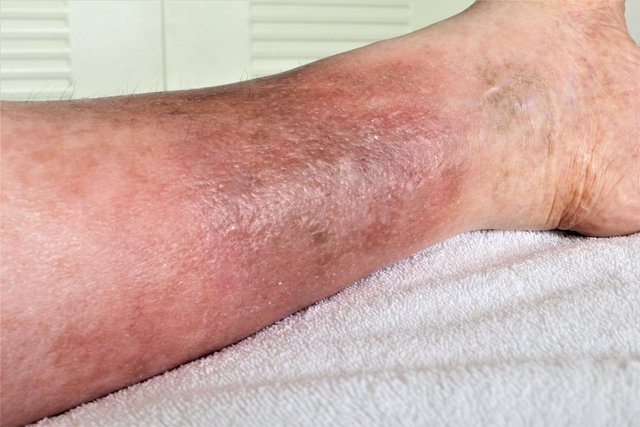Ocher dermatitis is an inflammation of the skin that is mainly caused by poor circulation in the legs, promoting the accumulation of blood and fluids that leak from the veins and put pressure on the inner part of the skin.
Thus, due to changes in circulation, the main symptoms of ocher dermatitis, also known as stasis dermatitis, are swelling, purplish or brown color, itching, pus-filled wounds and crusts on the legs and ankles.
In the presence of signs and symptoms indicative of ocher dermatitis, it is important to consult a general practitioner, dermatologist or vascular surgeon, so that the diagnosis can be confirmed and appropriate treatment initiated, which can be done with the use of corticosteroids, antibiotics and stockings. compression.

Symptoms of ocher dermatitis
The main symptoms of ocher dermatitis are:
- Itching in the lower part of the legs;
- Swelling in the legs and/or ankles at the end of the day;
- Brown or purple coloring on the legs and/or ankles;
- Dry skin;
- Skin irritation and sensitivity.
When left untreated, ocher dermatitis can cause scaling, hardening of the skin, pus-filled sores, or shrinkage of the skin on the lower calf, which is known as lipodermatosclerosis.
Furthermore, when ocher dermatitis is not treated, it can also cause contact dermatitis or cellulitis, which is an infection of the deeper layers of the skin, causing symptoms such as intense redness, pain and swelling. Learn more about cellulite.
Online symptom test
Ocher dermatitis is a type of dermatitis, such as atopic dermatitis and seborrheic dermatitis. To find out the chances of having dermatitis, please select the symptoms you present:
This test only serves as a means of guidance and is not intended to provide a diagnosis or replace consultation with a dermatologist or general practitioner.
How to confirm the diagnosis
The diagnosis of ocher dermatitis must be made by a general practitioner or dermatologist, who will evaluate the signs and symptoms on the skin and legs, and the person’s health history.
In addition, the doctor may also order some exams and tests to confirm the diagnosis of this type of dermatitis, such as blood tests, Doppler ultrasound, to assess blood circulation, and allergy testing, to rule out a possible allergic reaction.
Causes of ocher dermatitis
The main cause of ocher dermatitis is poor circulation, which causes blood to accumulate in the legs and, more rarely, in the arms. Blood and fluids accumulated in the legs leak from the veins and put pressure on the skin, causing the symptoms of ocher dermatitis. Therefore, some factors that are related to the emergence of ocher dermatitis are:
- Varicose veins;
- Overweight;
- Sedentary lifestyle;
- Sitting or standing for a long time;
- High pressure;
- Renal insufficiency;
- Thrombosis;
- Cardiac insufficiency.
Furthermore, being 50 years of age or older, being a woman or becoming pregnant frequently are other risk factors associated with the development of ocher dermatitis.
How the treatment is carried out
The treatment of ocher dermatitis must be indicated by a general practitioner or dermatologist and includes:
- Medicines: oral medications, in the form of creams or ointments, such as corticosteroids, antibiotics or antihistamines, may be prescribed;
- Compression socks: are recommended to help improve blood circulation in the legs;
- Sanitization and dressings: are indicated to treat wounds that may appear during this dermatitis;
- Intense pulsed light: is a treatment that helps remove dark spots on the skin caused by ocher dermatitis;
- Physical exercises: Physical exercise improves blood circulation, strengthens the calf muscles, and helps maintain or lose weight.
Other recommendations to help treat ocher dermatitis are taking a cold shower, avoiding foods high in salt, drinking plenty of water and elevating your legs above heart level for 15 minutes every 2 hours and/or when sleeping.
Bibliography
- AGNIHOTHRI, Ritesh; SHINKAI, Kanade. Stasis Dermatitis. Jama Dermatology Patient Page. Vol.157. 12.ed; 1524, 2021
- AMERICAN ACADEMY OF DERMATOLOGY ASSOCIATION. Eczema types: stasis dermatitis overview. Available at: <https://www.aad.org/public/diseases/eczema/types/stasis-dermatitis>. Accessed on January 30, 2023
- NATIONAL ECZEMA ASSCIATION. Stasis Dermatitis. Available at: <https://nationaleczema.org/eczema/types-of-eczema/stasis-dermatitis/>. Accessed on January 30, 2023

Sign up for our newsletter and stay up to date with exclusive news
that can transform your routine!
Warning: Undefined array key "title" in /home/storelat/public_html/wp-content/plugins/link-whisper-premium/templates/frontend/related-posts.php on line 12
Warning: Undefined array key "title_tag" in /home/storelat/public_html/wp-content/plugins/link-whisper-premium/templates/frontend/related-posts.php on line 13



